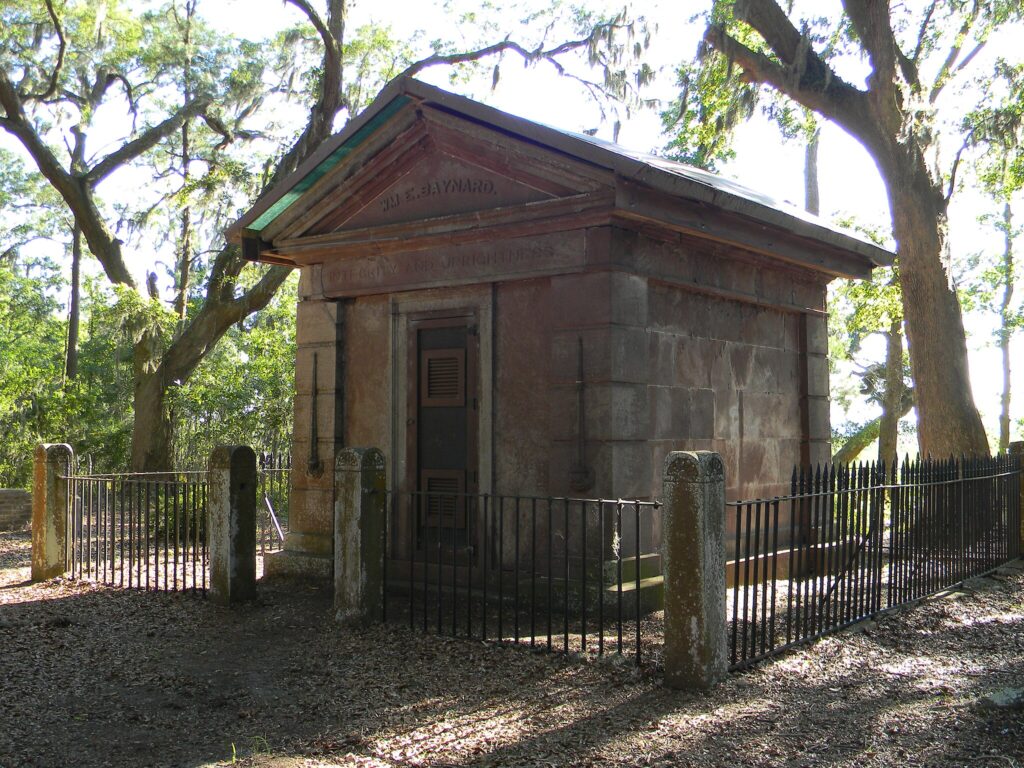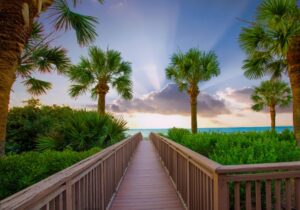While Hilton Head Island is most known for its beautiful, white sand beaches and its famous golf courses, the island also has a rich history. Hilton Head was home to the first self-governed town for the formerly-enslaved, Mitchelville. And the Gullah culture extends far beyond Mitchelville.
There are also other bits of history on the island — from the oldest structures left standing to the Harbour Town Lighthouse, which became a Hilton Head icon and played a role in the RBC Heritage coming to our little island.
If you’re interested in learning more about Hilton Head’s history, here are some locations you should visit on the island — plus some historical tours that are available:
Visit Historic Mitchelville Freedom Park
The site of Mitchelville is now a public park complete with historical artifacts and plaques allowing you to go on a self-guided tour. You can also request a private tour of the park on their website. It’s a great way to learn about the Gullah culture and the lives of the newly-freed slaves on the very land on which they built the first self-governed town of the formerly enslaved.
Mitchelville Freedom Park also hosts a variety of exhibits and events throughout the year. Learn more on their website.
The Gullah Museum of Hilton Head Island
Another great place to learn about the Gullah history on Hilton Head is The Gullah Museum. The goal of this museum is to show people what life was like on the island before the bridge to the mainland was built — when the majority of islanders were the Gullah people, descendants of freed slaves.
Visits to this museum are private by appointment only and cost $25/person. However, the museum regularly hosts events like the annual Gullah Food Festival, and the founders make appearances at other local events with some of the Gullah artifacts. You can also watch a video presentation of their story on their website.
Gullah Heritage Trail Tours
Another way to learn about the Gullah culture from native islanders themselves is to book a Gullah Heritage Trail Tour. From the website:
Learn about the culture of Gullah people during a two-hour narrated bus tour, and other Hilton Head activities. The tours are narrated by native Gullah folks who are descendants of former slaves dating back to years immediately after the Civil War. You will travel through the Gullah communities on Hilton Head Island when the island’s landscape was only farmlands, trees, dirt roads, wildlife and natural waterways throughout and around the island. The distinctive Gullah language, traditional foods, and recipes, music, religion, social structure, and folktales will all be woven into an interactive educational and entertaining experience. You will come away with an understanding of how the descendants of former enslaved people developed and maintained these communities on the then-isolated island.
Learn more about these tours and book your trip here.
Bonus: Head to nearby St. Helena Island to visit the Penn Center, the first school in the South for formerly enslaved West Africans. It also served a huge role in the Civil Rights movement as a meeting place; Martin Luther King, Jr., even penned some of his famous speech here.
Coastal Discovery Museum
The Coastal Discovery Museum is another great place to learn about the history of the island — as well as about the island’s native plants and wildlife. They have weekly lectures that vary by season, as well as both full-time and rotating exhibitions and tours.
It’s also a great place to bring curious kiddos — they have plenty of hands-on exhibits and lectures for the little ones throughout the year.
This is really one of the best places to learn about all of the history on the island — from the Gullah culture to military history to the arts. Learn more on their website.
Zion Chapel of Ease & Baynard Mausoleum
The Baynard Mausoleum is the oldest standing structure on Hilton Head Island. From the Heritage Library:
This is the site of the first chapel on Hilton Head Island which was completed in 1788. This location was the center of activity on the island in the late 18th and early 19th centuries, as the chapel was in close proximity to a Militia muster house and a Masonic lodge. It is also home to the oldest existing structure on the island, the Baynard Mausoleum, which was built in 1846 by William Baynard, a wealthy Plantation owner. The cemetery contains the graves and memorials for four Revolutionary War Patriots: Isaac Baldwin, James Davant, John Stoney, and Charles Davant. Charles Davant was ambushed by a Tory militia unit, was mortally wounded, and is the only known Patriot casualty on the island.
You can take a tour of the site with the Heritage Library from April through October — complete with costumed tour guides. Learn more here. You’re also welcome to visit the site yourself during daylight hours.
Historic Forts on the Island
The Heritage Library also offers tours of Fort Mitchel, one of the Civil War forts on the island. From the website:
The site contains the remains of a coastal defense battery erected in 1862 to protect the Port Royal Sound by way of Skull Creek from incursions by Confederate gunboats based in the Savannah River. Costumed characters and an expert tour guide will demonstrate the vital historic importance of this place and the role the fort and its namesake, General Mitchel, played in shaping Hilton Head history, including historic Mitchelville.
These tours are also available April through October. Learn more here.
Another fort on the island is Fort Howell.
Fort Howell was built to defend Freedmen’s Village of Mitchelville. From the Heritage Library:
While the fort saw no action, it served as a testament to the excellent skills in military engineering exhibited by the men of the day as a permanent and defensible earthwork fort … It served to protect the village of Mitchelville, the road to Port Royal Sound, and the main army depot at Coggins Point from attack. Guns placed for defense of the fort were taken from the dismantled Fort Seward on Bay Point.
… In 1993, Fort Howell, the only fort built by all-black troops to protect an all-black town, was given over to the Hilton Head Island Land Trust for maintenance and preservation so future generations can enjoy learning about this historic site. The fort currently sits off Beach City Road on the left-hand side about a mile from Highway 278 not far from the former freedman’s village of Mitchelville and the intersection of Beach City Road and Dillon Road. Admission is free and the site is open from dawn to dusk, however, parking is minimal. So if one is up for a short hike, Fort Howell is a great place to stop and enjoy the history and the outdoors.
Just look up the intersection of Beach City Road and Dillon Road to visit the fort yourself. It’s a great place to go after visiting Historic Mitchelville Freedom Park!
Another fort on the island is Fort Walker/Welles. This fort played a huge role in the Battle of Port Royal. Constructed by the Confederates, it was captured in the Battle of Port Royal by Union forces. This led to the slaves of the Sea Islands being freed, and the establishment of the Village of Mitchelville. You can learn more about the Battle of Port Royal here and here.
The Coastal Discovery Museum also offers tours of the Forts of the Port Royal, which includes visiting the site of the former fort.
Harbour Town Lighthouse & Museum
If you want to learn more about the golf and tourism history of the island, you should visit the Harbour Town Lighthouse & Museum. Not only does the lighthouse provide spectacular views, but you can learn all about the creation of the Sea Pines Resort and how the lighthouse — and the RBC Heritage — put Hilton Head on the map. Check it out here.





